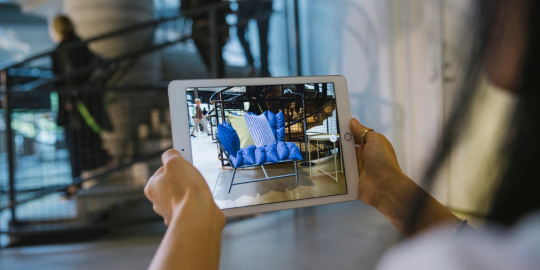
The Dawn of a New Era: Introduction to Augmented Reality in Gaming
Augmented Reality (AR), widely recognized as the sister branch of virtual reality, has emerged as an extraordinary and transformative milestone in the ongoing evolution of video technology. This innovative technology grants gamers the remarkable ability to seamlessly merge with their physical surroundings, thereby bringing their digital gaming experiences to vibrant, immersive life. The potential of AR has only just started to be realized, ushering in a plethora of unique and groundbreaking possibilities for the future landscape of gaming. With AR, the boundaries between the virtual and the real world blur, creating an entirely new realm of interactive entertainment that promises to captivate and engage players in unprecedented ways.
Changing the Game: How AR Enhances User Experience
The beauty of augmented reality truly resides in its remarkable ability to seamlessly fuse a gamer's physical environment with a dynamic digital overlay. This innovative technology places game elements directly into users' real-world surroundings, creating an intriguing and captivating blend of natural and virtual interactions.
By integrating these elements into the actual physical space, augmented reality adds an increased visual dimension that significantly elevates the gamer's overall experience. This approach not only enhances immersion but also offers a level of interactivity that is vastly superior to conventional two-dimensional gaming engagements. Gamers find themselves walking through their own living rooms or local parks, where mythical creatures might be hiding behind the couch or virtual obstacles could appear on familiar pathways.
This spectacular convergence of worlds opens up endless possibilities for creative gameplay scenarios and a revolutionary reimagining of interactive entertainment.
Unplugged: Accessibility and Mobility of AR Games

One significant benefit that differentiates augmented reality (AR) gaming from older video technology is the enhanced freedom of movement it offers. Unlike traditional gaming systems that require a fixed setup and tethered equipment, players can now engage in dynamic interactive play wherever they are—whether relaxing at home, taking a break at work, or even during their daily travels. This newfound flexibility, coupled with the widespread availability of smartphones equipped to handle advanced A.R. applications, has made this form of gaming increasingly available to a broader audience.
A Whole New World: Illustrative Examples
Pokémon Go is perhaps the most popular and widely recognized example of how augmented reality (A.R.) can revolutionize the world of gameplay. This groundbreaking game ingeniously employs GPS navigation and smartphone cameras to create an immersive experience that makes it seem as if Pokémon are actually roaming through our parks, streets, and neighborhoods.
This clever and innovative use of technology has led to unprecedented waves across global app stores, captivating millions of players worldwide. The game's success brought people outdoors in search of virtual creatures and highlighted the immense power and potential A.R. holds when combined with well-loved and cherished classics. Pokémon Go has undeniably set a high standard for future A.R. applications and continues to inspire developers to explore new and creative ways to blend our virtual and physical worlds.
Gaming for Everyone: Moving Beyond Entertainment
While most people commonly associate augmented reality (AR) with entertainment and gaming, its applications extend far beyond these domains. A.R. finds valuable uses in a wide array of fields, including education, professional training, tourism, healthcare, and many other areas in between.
In the realm of education, for example, A.R. can offer students innovative ways to grasp complex subject matter, such as visualizing intricate scientific concepts or experiencing more engaging historical walkthroughs. These immersive learning tools can make a significant difference in students' understanding and retention of information.
In the medical industry, augmented reality holds transformative potential for both healthcare training and surgical simulations. Medical professionals can leverage AR to create detailed and interactive training environments that mimic real-world scenarios without any of the associated risks. This kind of technology enables medical practitioners to practice and refine their skills, leading to better preparedness and outcomes in actual clinical settings.
The versatility of augmented reality ensures that it is not confined to a single purpose, allowing it to enhance and improve various elements of our daily lives across multiple sectors.
Looking Ahead: The Future of AR Gaming

As technological advancement surges forward with remarkable speed, propelled by innovations in various fields, it's reasonable to infer that the potential applications of Augmented Reality (AR) within the realm of gaming hold boundless possibilities, transforming the gaming landscape in unprecedented ways.
There's a dazzling array of potential enhancements on the horizon that promise to revolutionize the way players interact with digital environments. For instance, future advancements in haptic feedback technology could provide tactile sensations that significantly blur the lines between real and virtual elements, offering a more immersive and physically engaging gaming experience.
Moreover, developments in artificial intelligence (AI) could be harnessed to create highly personalized player experiences, tailoring game dynamics, narratives, and character interactions to individual preferences and behaviors. Imagine games that adapt in real-time to your skill level, emotional state, and even your physiological responses, making each gaming session uniquely tailored to you.
As AR technology continues to evolve, the integration of sophisticated AI, coupled with realistic sensory feedback, could lead to a new era of gaming where the distinction between the digital and physical worlds becomes increasingly seamless, unlocking a level of immersion and interactivity that was once the stuff of science fiction.
In Summary: The Impact Of Augmented Reality In Gaming
Augmented Reality (AR) has not only diversified the realm of gaming but has also extended its influence into various other sectors, such as education, healthcare, and beyond. This groundbreaking technology enhances real-world interactions by overlaying a digital layer, which introduces an immersive and engaging aspect to video games, making them more interactive and dynamic. The adaptation of AR into video games has transformed them into an experience that is simultaneously more portable and easily accessible than ever before. Unlike traditional gaming set-ups that require specific hardware, AR-based games can be played using devices that many people already own, such as smartphones and tablets, thus broadening their reach.
In the field of education, AR can create vivid and interactive learning environments, allowing students to visualize complex concepts and participate in dynamic simulations that traditional education tools cannot offer. For instance, medical students can practice surgeries in a risk-free virtual setting or history students can take virtual tours of ancient civilizations. In healthcare, AR is starting to play a crucial role as well. It supports doctors during surgeries by providing real-time data and visualizations, improving accuracy and outcomes. For patients, AR can assist in physical rehabilitation and mental health treatments by creating interactive and engaging exercises.
The application of AR in gaming serves as a significant marker of how technological advancements are shaping and revolutionizing every aspect of our day-to-day lives. This transformative leap forward demonstrates not only the versatility of AR but also signals a future where digital and physical worlds are seamlessly integrated, enhancing our capabilities and enriching our experiences in ways previously unimaginable.